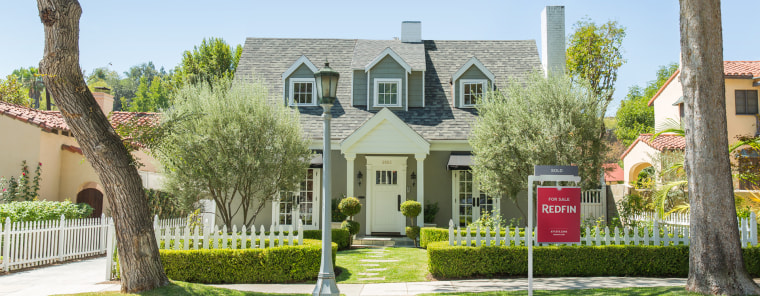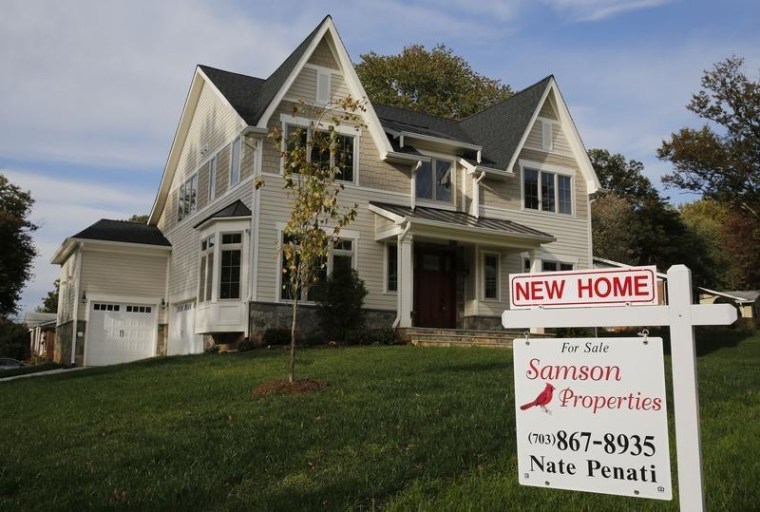The American Dream is becoming more like a desert mirage for some first-time home buyers, getting farther away the more they grasp for it.
Home prices are shooting up at more than twice the pace of average earnings growth, rising 5.9 percent vs 2.5 percent, according to the newly released Standard & Poor’s CoreLogic Case-Shiller 20-city home price index and the Bureau of Labor Statistics. It represents the largest increase since July 2014.

Even though the National Association of Realtors has seen an uptick in millennial buyers this year, the low housing supply means competition is fierce, especially in hot markets.
Matthew Massee, a 25-year-old online marketing professional, and his wife moved to Salt Lake City, Utah for the lower cost of living — but still find that housing prices are rising faster than their own salaries.
"We both come from middle-class backgrounds, are college educated, and have jobs," he told NBC News. "In the future we want to buy a house, especially because we want children, but the outrageous prices demanded by the current market mean we will likely never be able to afford a house."
"You go to look at houses on Saturday, and on Sunday you get an email from the realtor that they have 10 offers lined up so get your best offer in on Monday at 9 a.m.," said Jill Freshwater, a 34-year-old researcher and mother in Dallas, Texas. Ultimately she and her family had to increase what they were willing to pay by $60,000. And now that they've bought a house, their property values have gone up by $100,000 in the past year.
The forces of rising prices and stagnating wages are converging on household budgets even as the nation is returning to "full employment," loosely defined as the point at which everyone who wants a job has one.
"It certainly means that families are going to have a harder time making ends meet," said Elise Gould, a senior economist at the Economic Policy Institute, a DC-based nonpartisan think tank. "We see a relatively slow growth in wages compared to faster rising expenses; we see that in homes, healthcare, childcare, many of the necessary expenses families pay."
Is Avocado Toast to Blame?
But some bankers say that the real problem is that some first-time home buyers have stars in their eyes when they should be counting their pennies. Millennials are known for their frugality and their determination to put money aside — but not everyone does.
"Some people save and some people don't. They frivol their money away on avocado toast at brunch every week or on expensive car leases," said Joseph Allen, vice president and senior mortgage lending officer at Quontic Bank, in New York City, which makes home loans nationwide. (His comments echoed those made by real estate mogul Tim Gurner who recently drew international social media fame and ire after telling 60 Minutes when he was buying his first home he was working hard, not buying smashed avocado on multi-grain toast for $17 a pop.)
Allen recommends buyers set their expectations lower for their first homes and consider a fixer-upper or something outside their desired neighborhood.
"The guidelines are very black and white. There's no pushing the envelope. Either you fit the bill or you don't," he said.
Related: This Spring is the 'Strongest Market Ever' for Home Selling
That bill has gotten harder to fit for current generations.
For the sake of a comparison, consider that under a classic rule of thumb, you shouldn't spend more than 28 percent of your income on housing costs. (Though millions do).
The median price of a new home in 1970 was about $24,000, according to BLS data. So to afford it under the old-school rule, you only needed to make $6,720 a year — just a hair above the median income at the time, about $6,000.
Adjusted for inflation, that house that would cost $144,000 and you would only need to make $40,000 a year in order to be able to safely afford it.
According to the latest available comparable data, in 2015 the median price of a new home was about $300,000. To afford that, you would have to be making $84,000. That's well above the median income of $55,775.
So you'd need to do more than just skip the avocado toast to bridge that stagnating wage gap.
A Smaller Home
For Anne Hawkins, a 28-year-old marketing professional from New Hampshire who is struggling to buy a home with her boyfriend, the American Dream means something different than it did 50 years ago.
They both make around $50,000 a year but are having trouble putting together a down payment after their savings were depleted by a bout of unemployment and graduate school costs.
"I have never wanted to be a homemaker, so the idea of living the June Cleaver dream sounds more like a nightmare to me," Hawkins told NBC News.
One way they're making the idea of owning a home more affordable is considering that it might not need an extra bedroom for children.
"For myself and my peers, I think the dream is less about ticking off these boxes of material things, and more about finding a fulfilling career and building a life around that," said Hawkins, which "is less likely to include kids than ever before."

